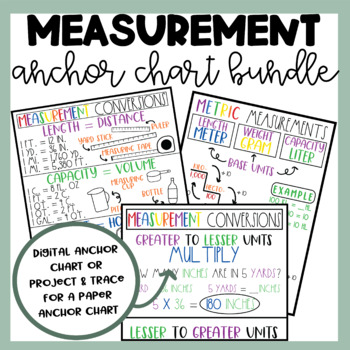Math Anchor Charts | Measurement Bundle | MD.1 | Digital Anchor Chart | 3 Charts
- Zip
What educators are saying
Products in this Bundle (3)
Also included in
- Introducing our comprehensive Fourth Grade Math Mega Bundle – your one-stop solution for mastering all the fourth-grade math standards! This bundle combines all the digital step-by-step instruction products from our collection, offering a treasure trove of resources to support your students' math lePrice $63.00Original Price $71.50Save $8.50
Description
Simplify teaching measurement conversions with our comprehensive Math Anchor Charts Measurement Bundle. Aligned with CCSS 4.MD.1, this bundle includes three detailed anchor charts for converting units of measurement. Perfect for visual learners, these charts support both digital and print use, making them a versatile addition to any classroom.
What's Included:
- Three Anchor Charts: Demonstrates how to make the conversions, the conversion charts needed with pictorial examples, and the metric conversion ladder with length, weight, and capacity base unit examples.
- Visual Aids: Clear illustrations and examples to aid understanding.
- Step-by-Step Instructions: Guides for converting between metric and standard units using multiplication and division.
- Digital and Printable Versions: Use in digital classrooms or print for physical displays.
Key Features:
- Aligned with Common Core Standards: Supports CCSS 4.MD.1 for measurement conversions.
- Visual Learning Aid: Enhances student understanding through clear visual representations.
- Versatile Use: Ideal for classroom displays, student reference sheets, and digital learning.
- Engaging Design: Keeps students engaged and makes learning measurement conversions fun.
Perfect For:
- Elementary and Middle School Teachers: Simplify the teaching of measurement conversions.
- Math Intervention: Provide extra support for students who need it.
- Homeschooling: Use as a visual aid to enhance math lessons at home.
- Tutoring: A valuable resource for math tutors working with students on foundational skills.
See more explicit details in the description of the three anchor charts included.
Measurement Conversion with Conversion Charts and Pictures
Metric Conversions with Base Units and Examples
These digital math anchor charts can be used digitally or you can project them to a wall, SmartBoard, whiteboard, or any flat surface and trace them on to your favorite anchor chart paper. I use a paper poster/anchor chart version to reference when teaching or working in small groups. I also insert the .png file in my presentations for reference.
Tags: Measurement and Data Standards, Length Conversions, Capacity Conversions, Weight Conversions, Time Conversions, Division, Ratios, Metric Conversions, Standard Conversions, Convert Using Division, Convert Using Multiplication, Metric Ladder, 4.MD.1, Fourth Grade Math, Distance Learning Resource, Planogram Anchor Chart, Measurement Conversions, Math Strategies, Common Core Math, Visual Learning, Elementary Math, Middle School Math, Printable Math Resources, Digital Math Resources.



